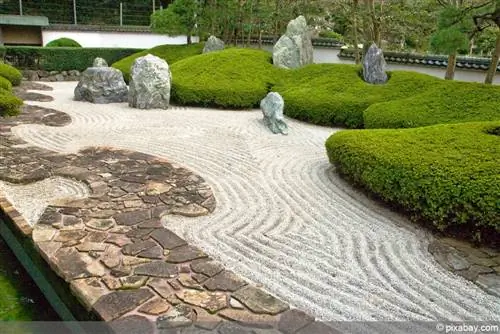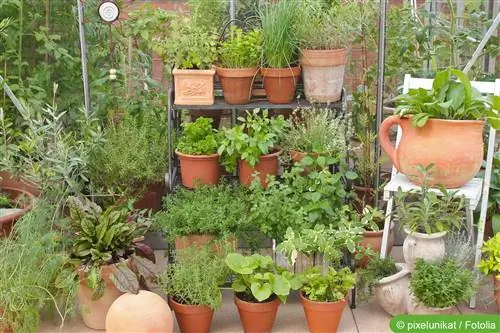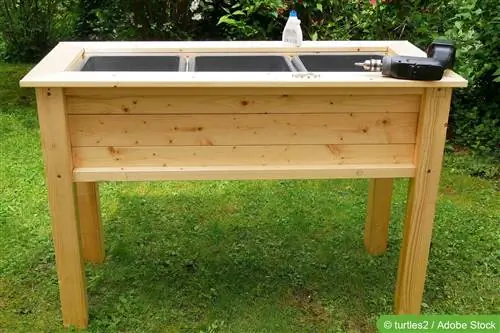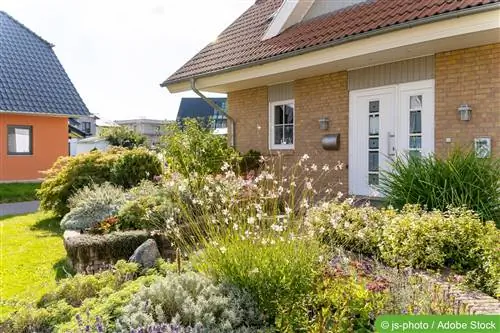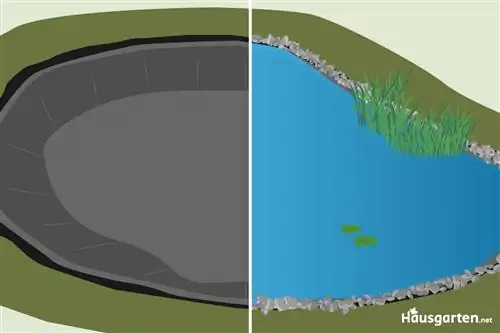- Author admin [email protected].
- Public 2023-12-17 03:39.
- Last modified 2025-01-24 12:45.
Zen gardens help with meditation, meditation helps us stay he althy despite stress, anger and worries - so a Zen garden is actually a must for every thinking and compassionate citizen today. You can easily create this Zen garden yourself, the instructions for outside and inside follow:
The purpose of the Zen garden
“Zen” is the short word for Zen Buddhism, a religion adapted from China in Japan from the 12th century onwards, to which around 80% of Japanese people today belong (at the same time as the original Japanese Shintoism, without precise demarcation). Zen garden care/meditation is one of the ways to practice Zen Buddhism, along with tea ceremony, penmanship, flower arranging, artistic bamboo flute playing and martial arts.
At the same time, the art of garden design in the Zen garden does not remain uninfluenced by Japanese garden culture, which in turn is an expression of Japanese philosophy and history. The special form of the Japanese garden, which is colloquially called Zen garden in German, is called Kare-san-sui in Japan, in German “dry landscape” or “dried landscape”. So a Japanese rock garden, dry garden or dry landscape garden, many of the most famous Japanese gardens are designed in the Kare-san-sui style.
The only plant species “permitted” in the Zen garden are gravel, stones, boulders and moss; water is indicated by wave-shaped structures in the gravel or sand areas. For Zen monks, contemplating the Kare-san-sui is as much a part of meditation as raking the rock gardens.
For a German gardener who is not experienced in the art of meditation, both of these may just be an opportunity to find a moment of peace in everyday life - but that's exactly what it's all about, peace and quiet every now and then in everyday life brings a lot, like you remember when planning your Zen garden:
The design principles of Zen gardening
Since only gravel, stones, boulders and moss need to be designed in a Zen garden, while the water is only hinted at by creating wave-like structures in the gravel, there are not too many basic principles to consider when designing. However, these should probably be carefully observed in order to achieve a harmonic effect that has been developed over the centuries to perfection:
- A defined base area is covered with sand or gravel
- Stones are distributed on it
- These boulders are intended to represent hills and mountains, so they should not be too uniformly shaped
- The arrangement of the stones must not result in a logical pattern or geometric shape
- The stones should rather “lie around randomly” as is the case in nature
- The stones should be “scattered” in odd numbers
- Five or seven large stones are usually used
- No mandatory limit, but rather due to the size of the area occupied
- The stones can be distributed in groups or placed individually
- Curving lines are drawn into the gravel areas with a wooden rake
- How deep and/or wide is up to the designer
- These curved lines are intended to symbolize the natural structures of bodies of water
- The designer decides whether it is a running stream or a pond limited to the Zen garden
- The only important thing is that there is no beginning or end of the lines within the Zen garden
- If several “symbolic bodies of water” touch each other, the lines of the patterns should also merge into one another
- The water areas are created around the stones because they are intended to highlight the stone settings
- What is crucial here is that the raked “water lines” flow around the previously placed stones
- First drawing the lines in the sand and then placing the stones on them is not permitted
- Such an approach would be considered an unsuccessful attempt to create an image of nature
- Strict rules, a simple and clear result; That's exactly how it should be
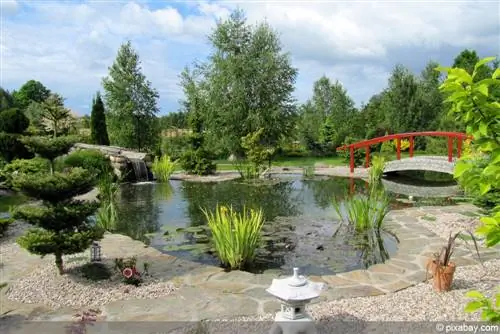
Probably Japan's most famous Zen garden in the Kare-san-sui style was created in the mid-15th century and is the main attraction of the Ryōan-ji Zen temple in Kyoto.30 x 10 meters of fine gravel with a few stones scattered in groups of moss - that's what makes up the entire famous Zen garden (the old wall in the background with its fine brown-orange tones reflects its own aesthetic concept).
Appears to make up the entire famous Zen garden, but in reality the whole thing is a well thought out, complicated composition: there are 15 stones, all of which are not visible together from any angle; The area is exactly the right size to distribute the stones in this way. The moss was placed around the stone groups in a precisely defined size, as was the surrounding raked circular “water areas”; the rest of the gravel area is raked in a straight parallel to the surrounding wall. This wall frames the Zen garden only to the south and west and provides a view of the trees and bushes of the walk-in garden behind it; To the north, the temple building adjoins a seating terrace from which you can overlook the rock garden.
Even in Japan, the Ryōan-ji Garden shows the pinnacle of self-restraint based on Zen design principles. Even with gravel, moss and stones, relaxing ensembles can still be created that depict lively landscapes. Sometimes there can be a few more (paving) stones, and the plants growing around them can have a huge impact on the image of the Zen garden. If the Zen garden is located in Verden, Lower Saxony, there is room for some plants other than moss without losing the Zen character.
Zen garden in the garden, step by step
The creation of the Zen garden is part of the “considered calming” that the garden will later serve. That's why the following is a clearly structured step-by-step guide so that you can let your mind wander as you go through the individual points:
1. Set area
The area for your dry garden should be as centrally located as possible, but as far away from frequently used paths as possible. Of course, it would be perfect if you could also catch a glimpse of the freshly raked surfaces from your desk, because not only “Zen with the rake”, but also the pure sight of it is calming.
Since size doesn't really matter, you can decide after you've found the right space. When selecting it, it is also crucial that it should be as flat a piece of garden as possible - at least for the gravel area, hills can be wonderfully incorporated if they are planted with mosses.
Whether it's an outdoor Zen garden in miniature format because there's a lot else going on in your garden, or you design the entire garden according to Zen principles and thus reduce garden maintenance to an annual effort of 10 minutes, is only important if you don't want to include very small bushes or trees. Certainly possible, but a tree with moss and a square meter of gravel around it looks rather silly.
2. Level the ground
The Zen garden only brings pure relaxation if the eye can rest on the gravel surface, and it cannot do that if the light is constantly refracted in small unevenness in the ground. So get a spirit level and a guideline and check the intended area in all directions. A spade helps with the smallest hills, and flat, gentle heights can be brutally but effectively leveled with a lawnmower (best with a dull lawnmower, as the blade will probably need sharpening once you've tackled ground surfaces).
If the ground is level, soft ground may still need to be compacted, either with the roller or by giving it time to settle.
3. Select barrier for the edge
A boundary at the edge helps a lot if the Zen garden is to be integrated into the garden. Due to the lack of old monastery walls, you will have to provide lawn edging stones, small box bushes or similar.
4. Gravel to fill in
Ask a local building materials supplier which gravel/coarse sand is best for your project. There are different sizes, sharp-edged stones and round pebbles; the latter can be raked into soft lines, while the sharp-edged gravel brings more expression to the surface.
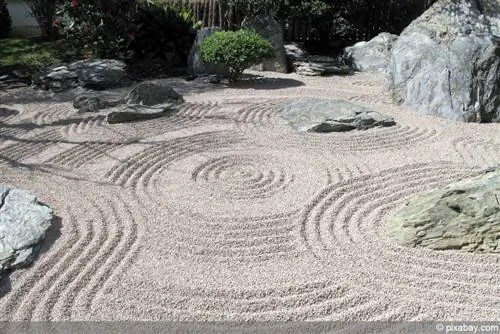
The gravel offers many more possibilities, including artistic activity - after all, it is available in white, gray, beige and in several colors.
5. Large field stones
The boulders for the Zen garden are also available from building materials dealers, but perhaps also from a quarry if there is one near you. Remember not to choose the prettiest, roundest stones, a few broken edges are just desired (and remember the odd number of boulders).
6. Moss
If you want to create a real Zen garden with moss, it needs to be planted first. Perhaps rather unusual because you've only ever been faced with removing moss from the lawn: moss plants are available to buy, e.g. B. the moss 'Forest Green', which forms a lush green carpet in no time.
7. Get Zen tools
Next you need a wooden rake that fits well in your hand and a sand trowel.
8. A few western accents?
With all respect for Zen traditions: whatever pleases is permitted; and when all sorts of self-proclaimed gurus introduce business Zen, ecology Zen, street Zen, therapy Zen and wellness Zen to us, you will not do any harm to the idea of Zen if your Zen garden is decorated with a few plants.
Of course, bamboo plants look very good in the Zen garden - but planting and care only remains "Zen" if you plant bamboo varieties that do not need a rhizome barrier and do not want to conquer your garden without it. Otherwise, you are likely to create more work in the garden with the “fastest-growing plants in the world”. All bamboos of the bamboo genus Fargesia, which are available at any height between 1.5 and 6 meters and are very hardy in our area, remain in their place.
Bamboos of the genus Shibataea are ideal for miniature Zen gardens, e.g. B. the butcher's broom bamboo Shibataea kumasaca, which grows barely higher than one meter, is a clump-forming dwarf bamboo that is hardy down to minus 20 degrees. You should avoid the bamboo genera Pseudosasa, Phyllostachys and Semiarundinaria; Phyllostachys in particular do not adhere to the boundaries of the Zen garden or the boundaries of the rest of the garden.
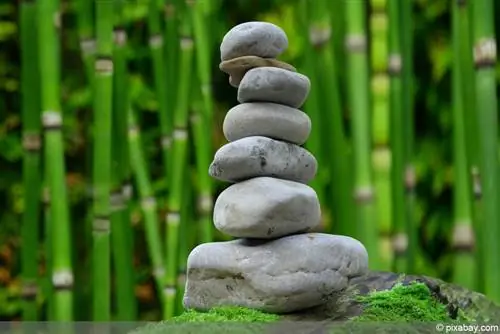
But it doesn't have to stay that way, you can integrate all the plants already growing in the garden that “keep their roots close”. Or explore the Japanese side of your favorite flowers; Would you have thought that our pansy was one of the symbols of the Japanese city of Osaka? You can even turn the Zen garden into a project that satisfies every gardening ambition: there are numerous bonsai that are cultivated in the garden.
9. Place stones and distribute gravel
Now it's getting concrete, but better first on a piece of paper with which you can spend a few cozy evenings. You could borrow a roller from the hardware store to distribute the gravel, so you can get very close to Zen perfection.
10. Nice accessories
It doesn't have to be bonsai junipers, which will only really look good in a few hundred years - you can use bamboo items, bridges, Buddhas, pagodas, shrines, stone lanterns, tea houses, animal figures and stepping stones, water basins.
11. Integrate real water?
Integrating water into the Japanese garden does not correspond to the classic Zen garden, but it is still up to you. A water basin certainly does not stand in the way of the goal of bringing nature and design into a harmonious balance. Wherever there are accessories for Japanese gardens, you will also find a selection of suitable basins.
12. Use the Zen garden often
Whether contemplation and raking gravel are “just” intended to ensure more serenity and relaxation or you want to take meditation seriously: Everyday life as an exercise is the path to transformation; and you can only learn to meditate by meditating.
Tip:
If you are not yet busy creating the Zen garden or the meditation does not yet bring the desired calm: you can continue with the rest of the garden, perhaps with a piece of garden designed according to Feng Shui. teaching is designed. Then the relaxation can be followed a little further by the unhindered, positive flow of energy, which allows the chi to flow freely and brings yin and yang into the right balance.
Miniature Zen Garden: Indoor Version
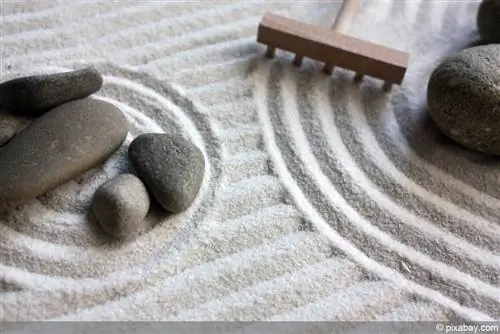
Simple mini Zen gardens are available to buy ready-made; Creating it yourself only costs a reasonably experienced hobby craftsman an evening:
- Build a rectangular frame of the desired size from a wooden board and wooden strips
- Approximately the size of a DIN A4 sheet can be easily handled on the desk or living room table
- Fill with sand or pebbles, here too you can choose between fine and coarse and different colors
- Or you can choose a particularly elegant variant and fill the frame with small semi-precious stones
- Zodiac gemstones or protective stones for/against certain emotions give the miniature garden personality
- Tumbled stones in your desired color open up a we alth of design possibilities
- a very small rake
And you can get started, raking with a very small wooden rake is very relaxing and is also quite fun because you can invent endless new patterns. But even with the miniature version, the simplest version is far from over: larger stones can also be integrated here, an indoor bonsai can be planted in the middle, and there may even be room for a small water basin with a miniature water lily pond.
But with the miniature Zen garden for the desk, decoration is usually deliberately avoided because otherwise there isn't much space left for “contemplative raking”. Unless you arrange the decorations around the outside where the miniature Zen garden sits when it is not in use. There, e.g. B. in the flower window or on the wide window sill, the mini Zen garden can stand in the middle of bonsais, an indoor bamboo (Bambusa ventricosa, Buddha belly bamboo) in the pot and Japanese decoration around it could complete the picture.
Tip:
A third option is the Zen garden on the balcony. Especially on visible balconies, it has two additional benefits: the balcony has never looked tidier, and numerous neighbors can relax with you.

